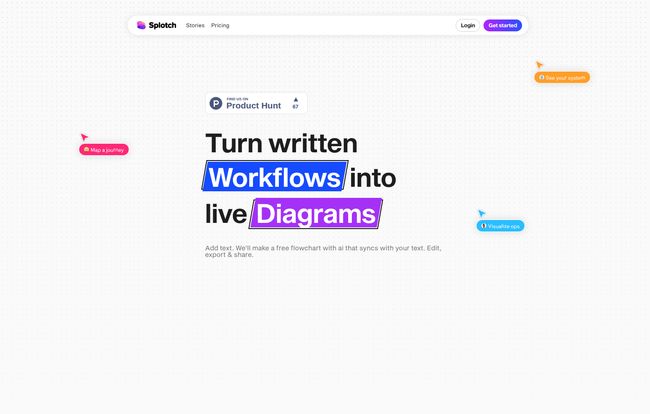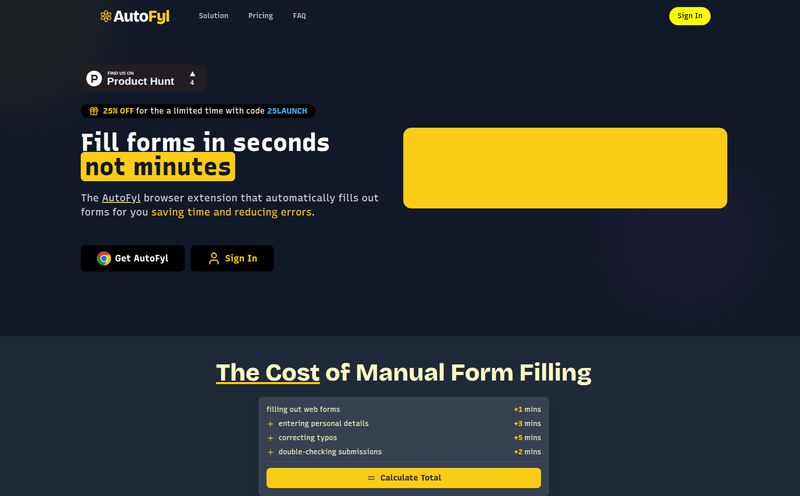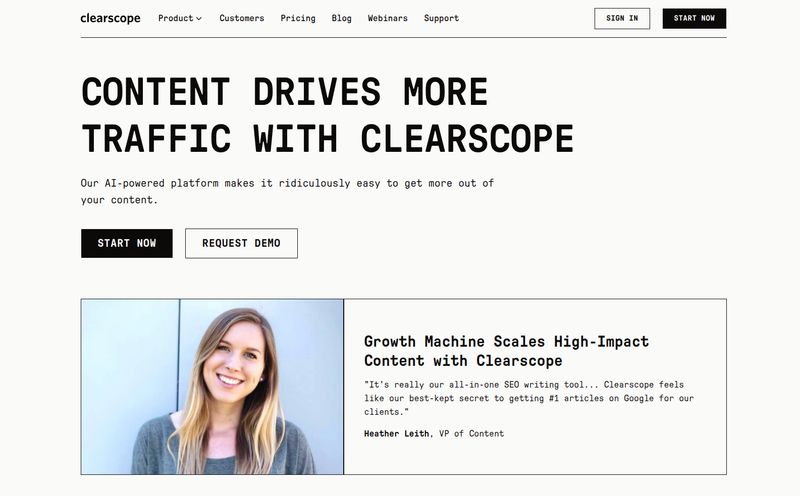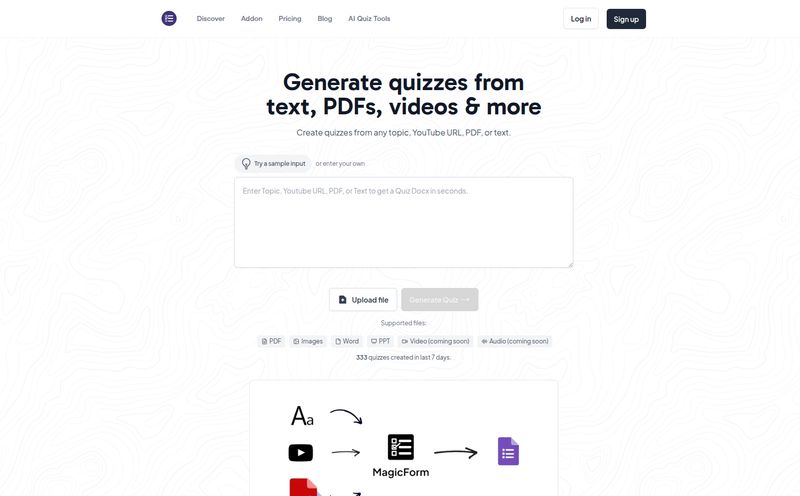If you've ever had to create a workflow diagram, you've felt the pain. You spend hours dragging boxes, connecting arrows, and wrestling with alignment tools in some clunky software that feels like it was designed in 2002. Then, someone on the team suggests a change. Just a small one. And your perfectly aligned masterpiece crumbles into a chaotic mess. The whole process has to start again.
I’ve been there. More times than I care to admit. As an SEO and process guy, I live in a world of funnels, user flows, and operational sequences. For years, my relationship with diagramming tools has been... complicated. It's a necessary evil. Or at least, it was.
Recently, a new tool called Splotch popped up on my radar, making some pretty bold claims. It’s an AI flowchart generator that turns plain text into live, editable diagrams. My first thought? “Yeah, right.” We’ve all seen AI tools that promise the world and deliver a slightly misshapen potato. But I’m a sucker for new tech that promises to save me time, so I had to give it a try.
So, What Exactly is Splotch?
Think of it this way: Splotch is like having a lightning-fast graphic designer and a meticulous technical writer working together inside your computer. You feed it the words—a set of instructions, a process description, even a messy brain dump from a Google Doc—and it spits out a clean, professional-looking flowchart. Instantly.
But here’s the kicker, the feature that made me sit up and pay attention. It’s not a one-way street. This isn't just text-to-image. Splotch has a magical two-way sync.

Visit Splotch
The Real Magic Is in the Two-Way Sync
This is the part that feels like a glimpse into the future. Let me break it down:
- You write some text describing a process. Splotch generates a diagram from it. Cool.
- You notice a step is missing in your text. You add it. The diagram automatically updates to include the new step. Very cool.
- You look at the diagram and decide to move a box. You drag it to a new position. The original text document re-writes itself to reflect that change. Mind. Blown.
This two-way sync is the secret sauce. It eliminates the single biggest frustration of process documentation: keeping the visual and the text versions aligned. It treats them as two sides of the same coin, not separate documents you have to update independently. No more outdated diagrams floating around in Slack channels! This alone is a massive win for team collaboration and creating a single source of truth.
Who Is This Workflow Visualization Tool For?
While I can see a ton of uses for it, the Splotch website calls out a few specific roles, and I have to agree. This isn't just for us tech nerds.
"It's easier to get buy-in when you can see the process." - A quote from the Splotch website that really hits home.
Project Managers and Designers
For PMs and designers, this is a dream. You can take a lengthy user story or feature requirement doc, paste it into Splotch, and instantly get a visual user flow. It makes it so much easier to spot gaps in logic or unintended dead ends before a single line of code is written.
Sales and Marketing Teams
Ever tried to explain a complex lead nurturing sequence or a sales qualification process? It’s tough. With Splotch, you can map out campaigns, POCs (proofs of concept), and entire marketing funnels visually. It makes getting buy-in from stakeholders or explaining the plan to your team a thousand times easier.
Operations and RevOps
This is where I think Splotch might be most powerful. For anyone in Ops, documenting Standard Operating Procedures (SOPs) is life. Splotch can turn your boring procedural documents into living, breathing diagrams that are actually easy to follow. Think about onboarding a new employee with an interactive, visual guide instead of a 20-page Word doc. It’s a huge timesaver.
A Look Under the Hood at Splotch’s Features
So it talks the talk, but what’s it actually like to use? The interface is clean and minimal, which I appreciate. No feature bloat here. You write or paste text on the left, and the diagram appears on the right. Simple.
The AI is surprisingly good, but it's not a mind reader. The clearer your instructions, the better the result. A list with bullet points or numbered steps works best. But even with a messy paragraph, it makes a decent first attempt that you can then clean up.
And that’s the other key feature: you have full editing control. If the AI puts a box in the wrong place, just move it. You can use the AI to help you edit (“Add a step after step 3 called ‘Send follow-up email’”) or just do it manually. This flexibility means you're not fighting the AI; you're working with it.
The Google Docs import and plugin is also a brilliant touch, since that's where so many processes are born (and die). Being able to pull a process directly from a GDoc and bring it to life is fantastic.
What's the Damage? Splotch Pricing
Alright, the all-important question: what does it cost? Splotch has a pretty straightforward pricing model. They offer a free plan and a Pro plan, both with a 14-day free trial to start.
| Plan | Price | Key Limits |
|---|---|---|
| Free | $0 | 1 project & 10 diagrams |
| Pro | $14/month (or $11/month if billed annually) | 10 projects & 200 diagrams |
In my opinion, the free plan is a great way to test the waters and see if it fits your style. But the limits are tight. For any serious, ongoing work, you'll need the Pro plan. Is it worth $11 a month? If you create more than one or two diagrams a month, I'd say absolutely. The amount of time and frustration it saves pays for itself almost immediately.
The Good, The Bad, and The Inky
No tool is perfect. After playing around with Splotch for a while, here's my honest take.
What I loved: The sheer speed is incredible. Going from a wall of text to a usable diagram in seconds feels like a superpower. The two-way sync is genuinely a game-changer and the primary reason to use this tool. It's also just plain easy to use—the learning curve is practically non-existent.
Where it could improve: Like all AI, its accuracy depends on your input. If your text is vague, be prepared to do some manual cleanup. And while the subscription model is standard these days, adding another monthly bill is always a consideration. The free plan's limits feel a little restrictive, pushing you towards the Pro plan pretty quickly if you're a heavy user.
Frequently Asked Questions About Splotch
I had some questions, and you probably do too. Here are some quick answers.
What kinds of text can I turn into flows?
Pretty much anything that describes a process. Think meeting notes, SOP documents, project plans, user stories, or even just a list of steps you jotted down.
Do I need to format my input text?
Not strictly, but it helps. The AI does a better job if you use lists (numbered or bulleted) or clear, sequential sentences. But you can throw a paragraph at it and see what happens!
How does the 2-way sync actually work?
It maintains a constant link between the text elements and the diagram nodes. When you edit one, the tool automatically applies the logical change to the other. Change the text in a box, and the source text updates. It's seamless.
Can I export my diagrams?
Yes, you can export your work. This is critical for sharing with people who aren't using Splotch or for including in presentations and other documents.
Is Splotch better than something like Visio or Lucidchart?
It's different. If you need to create a highly-customized, complex engineering diagram with dozens of unique shapes, traditional tools might still be your go-to. But for 90% of business process and workflow mapping, Splotch is infinitely faster and more intuitive.
My Final Verdict: Should You Use Splotch?
Splotch isn't trying to be a replacement for every diagramming tool on the planet. It’s a specialized process mapping tool that solves a very specific, very annoying problem. It closes the gap between the written word and the visual diagram, saving a ton of time and preventing miscommunication.
For me, it’s a definite keeper. It’s found a permanent place in my toolkit for outlining content strategies, mapping SEO processes, and just generally thinking more clearly. If your job involves turning ideas and processes into something others can understand and follow, I genuinely think you should give Splotch a try. That initial “Holy Cow” moment when you paste in some text and a perfect diagram appears is worth the price of admission alone.



